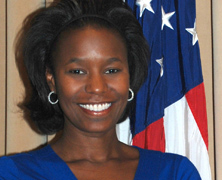I knew from age five that I wanted to be a lawyer—I always loved to debate and was co-captain of my high school debate team. So I went to law school after college. But after practicing employment law, and defending personnel and discrimination cases for 15 years at the US Department of Health and Human Services, I knew I needed a change. I wanted to do more proactive work that made a difference in people’s lives and had a more positive impact on organizations.
Leaving the field of law was a difficult decision because practicing law was something I had always wanted to do; however, I was attracted to diversity-and-inclusion work because it affects so many things. Understanding that people are different, and that their unique perspectives and skills can be leveraged to get to better business results, was appealing to me. In addition, diversity and inclusion are at the core of leadership. You cannot call yourself a leader if no one is following, so understanding diversity and figuring out how to leverage it are critical to effective leadership.
The biggest leadership challenge I faced in this transition was one I wasn’t expecting. As a lawyer, I’d always had a seat at the table. I had been sought out to provide counsel; the value of my work was never questioned. In my new role, however, I had to continually build the business case for diversity and inclusion, and for the need to have diversity leaders at the table. I was truly surprised by how difficult it was for some leaders to see how diversity contributes to the bottom line.
However, I’ve found that, no matter what organization I’m part of, employees are the most important resource. And the more diverse their thoughts, backgrounds, talents, and experiences are, the more successful the organization will be.
On Finding Success and Staying Competitive
As a diversity professional, I must constantly find ways to connect to the business of my organization. Convincing my executive leadership that diversity and inclusion can drive better business results is my priority. Not only do I have to stay current with the progressive thinking around diversity and inclusion, I have to know and understand my organization’s mission and business. Otherwise my program will have no value.
On the Importance of Role Models and Mentors
I have three role models. Beth Tucker, former deputy commissioner at IRS, is an incredible leader. She was smart, engaging, and strategic, but most of all, she cared about the people of this organization. Because people are the most valuable resource our organization has, we must make our employees our number one priority to ensure we meet the needs of taxpayers. Debra Chew and Georgia Coffey, heads of diversity at the National Institutes of Health and the Veterans Administration respectively, are also amazing leaders and visionary diversity thought leaders. I have benefited from working with each of them, and have learned from all three of these incredible women.







Happy Bosses Day and Congratulations on the honor of being a “Women Worth Watching”. I have admired your leadership as a suboridate from afar since you became our Executive Director. I look forward to more positive changes in our organization due to your inspired leadership. Again Congratulation !
I am indeed privileged to be an employee of Monica. She practices what she preaches and her dedication, pleasant attitude and hard work motivates those around her. IRS is very lucky to have her and I wish her more success in all your future endeavors.
I appreciate the work Monica has done at the IRS and her support of the employee organizations, especially those with disabilities and military veterans, both groups which bring unique values to any organization. Unspoken but showing the true value of a servant leader, she has empowered her employees to do great deeds to improve acceptance of diversity and the practice of inclusion.
I was an employee of Monica Davy. Monica is cultural influent and well understand diversity at work. She not an asset to EDI but IRS as a whole. She is mentor and ally to many aspiring leaders. Monica congrats.
Correction: I meant that Monica is not only an asset to EDI but also to IRS as a whole. Congrats again.
This article/profile of Pheona is like a breath of fresh air. The person I see in reading this is inspiring and role model worthy. Thank you for the encouragment, from the workforce!
Correction, I meant to say I was referring to Monica, not Pheona. I had read her comment and mis-entered her name. Again, tahnk you for this article.
I knew when I first heard Monica speak, she was a “woman worth watching”! Congratulations on this honor, and I’m sure there will be many more to come. Yes indeed!
Congratulations on the Award! It’s truly a great honor to be recognized for a job well done. As a new employee to the Service, I am glad that there is such great leadership, and leadership that puts the employees first! I admire you, and the work that you do. Again, congratulations.
Monica is indeed a “woman worth watching” – smart, committed, and most importantly, grounded in principle-based leadership. She caught my attention years ago and I am so proud to have witnessed her growth in our critical field of diversity and inclusion. By advancing the business case for diversity in addition to the legal imperatives of EEO, she has elevated diversity and inclusion to a new level in the public sector. Im very proud of you Monica and look forward to seeing even greater things!